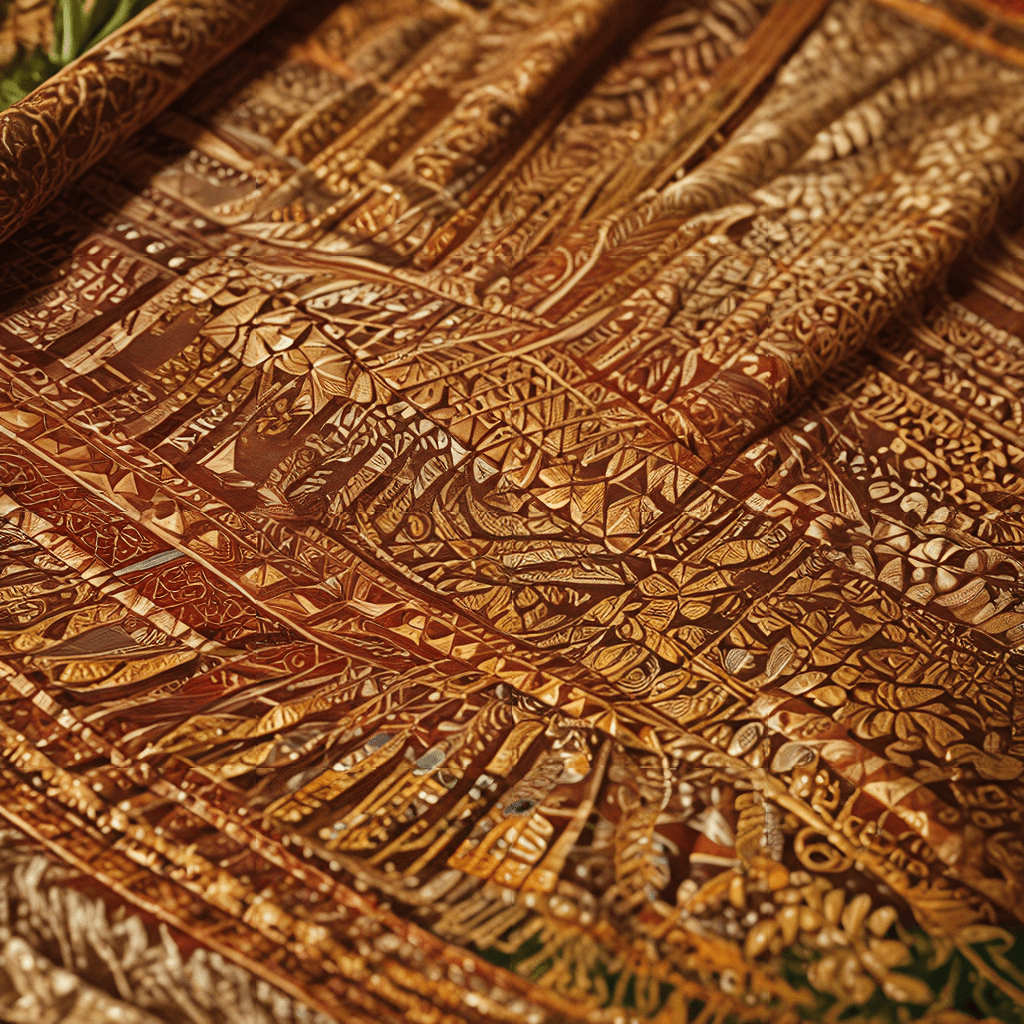Hawaiian Kapa Cloth: Unveiling Ancient Symbolism
In the heart of the Pacific Ocean, where the volcanic peaks of the Hawaiian Islands rise from the waves, lies a rich tapestry of cultural traditions. Among these is the art of kapa making, a practice deeply rooted in the spiritual beliefs and social fabric of the Hawaiian people. Kapa cloth, created from the bark of the paper mulberry tree, is more than just a fabric; it is a living embodiment of Hawaiian history, cosmology, and identity.
The Cosmic Origins of Kapa Cloth
In Hawaiian mythology, the creation of kapa is intricately linked to the origins of the universe. The story of the demigod Ku, who shaped the islands from the primordial sea, also speaks to the birth of kapa. Ku's wife, Hina, is credited with discovering the process of making kapa, using the bark of the paper mulberry tree as her raw material. This origin story underscores the sacred significance of kapa, connecting it to the very foundation of the Hawaiian world.
The paper mulberry tree itself holds deep symbolic meaning. It is associated with the goddess Laka, who embodies the forces of nature, fertility, and hula. The tree's bark, when transformed into kapa, represents the interconnectedness of life, the cyclical nature of creation and renewal, and the enduring power of the natural world.
Kapa Cloth: A Physical Manifestation of Hawaiian Spirituality
Kapa cloth is not merely a material object; it is a tangible representation of Hawaiian spirituality. The process of making kapa is itself a spiritual practice, embodying respect for the natural world and the interconnectedness of all things. From the careful selection of the paper mulberry tree to the meticulous process of pounding and smoothing the bark, each step is imbued with reverence and intention.
The creation of kapa involves a harmonious blend of human skill and divine guidance. Hawaiian artisans believed that the spirit of the tree itself was infused into the cloth, making it a sacred object. The act of wearing kapa was akin to wearing a piece of the natural world, a symbol of one's connection to the earth and the ancestors.
The Sacred Role of Kapa in Ritual and Ceremony
Kapa held a prominent place in Hawaiian rituals and ceremonies, serving as a conduit for spiritual energy and a symbol of power and authority. It was used in religious ceremonies, including offerings to the gods, as well as in royal events, signifying the status and lineage of chiefs and ali'i.
Kapa was also used to adorn temples, representing the sacredness of the space and the presence of the gods. Wrapped around offerings, it served as a vehicle for connecting the material world with the spiritual realm. The use of kapa in ceremonies underscored its position as a powerful symbol of cultural continuity and spiritual connection.
Kapa Patterns: A Language of Ancestry and Identity
Each kapa pattern was more than just a decorative element; it was a visual language that spoke volumes about the wearer's lineage, status, and cultural identity. These patterns, often intricate and symbolic, were passed down through generations, carrying with them the stories and traditions of the ancestors.
The intricate designs found on kapa, known as "kapa mo'o," were often inspired by natural elements like plants, animals, and celestial bodies. Each motif held specific meaning, reflecting the beliefs, values, and cultural knowledge of the Hawaiian people.
The Symbolism of Common Kapa Motifs
The rich tapestry of kapa patterns reveals a fascinating world of symbolism. Some common motifs and their associated meanings include:
- Ipu (gourd): Represents fertility, abundance, and the creative power of the universe.
- Mo'o (lizard): Symbolizes guardianship, wisdom, and the connection to the ancestors.
- Makani (wind): Represents the breath of life, spiritual energy, and the ever-changing nature of the world.
- Kula (fishnet): Symbolizes interconnectedness, collaboration, and the bonds of community.
- Lei (garland): Represents beauty, celebration, and the interconnectedness of life.
These motifs offer a glimpse into the depth and richness of Hawaiian cultural knowledge, weaving together themes of nature, spirituality, and the enduring bonds of community.
The Significance of Color in Kapa Cloth
The colors used in kapa cloth were not merely decorative; they held deep spiritual and symbolic meanings. Red, for example, associated with the god of war, Ku, represented strength, power, and vitality. Yellow, linked to the sun god, Lono, symbolized abundance, prosperity, and the life-giving power of the sun. Black, often used to depict the night sky, represented the mysteries of the universe and the unseen forces of the world.
The choice of color was often determined by the occasion and the intended wearer. A kapa cloth in red might be worn by a warrior preparing for battle, while a kapa in yellow might be reserved for a chief during a ceremony honoring the god Lono. The colors of kapa, therefore, served as a visual language that conveyed a multitude of meanings and messages.
Kapa Cloth as a Medium for Storytelling
Kapa cloth was not just a canvas for decorative patterns; it was a medium for storytelling, preserving the history, myths, and legends of the Hawaiian people. Kapa makers would weave stories into the cloth through their intricate designs, each motif representing a character, event, or concept from their oral traditions.
These stories, passed down through generations, provided a rich tapestry of knowledge about Hawaiian history, culture, and spirituality. Kapa cloth, therefore, served as a visual library, preserving the cultural heritage of the Hawaiian people and ensuring its transmission to future generations.
Kapa Cloth and the Continuity of Hawaiian Culture
The art of kapa making, despite being challenged by modernization and cultural suppression, continues to thrive in Hawaii today. Contemporary Hawaiian artists, inspired by the traditions of their ancestors, continue to create kapa cloth, weaving their own stories and experiences into the fabric.
The resurgence of kapa making represents not only a return to traditional art forms but also a reaffirmation of Hawaiian cultural identity. Through this ancient art, the Hawaiian people connect with their past, celebrate their heritage, and ensure the continuity of their cultural legacy.
Theorizing the Symbolism of Kapa Cloth: A Psychoanalytic Perspective
From a psychoanalytic perspective, the symbolism of kapa cloth reflects the deep-seated psychological needs and desires of the Hawaiian people. The intricate patterns and motifs, often inspired by nature, represent the human need to connect with the natural world and find meaning in the mysteries of life.
The use of kapa in rituals and ceremonies reflects the human need for order, meaning, and connection to something greater than oneself. The act of creating and wearing kapa, therefore, can be seen as a way of expressing and managing the complex emotions and anxieties that are inherent in the human experience.
Theorizing the Symbolism of Kapa Cloth: A Feminist Analysis
A feminist analysis of kapa cloth highlights the role of women in Hawaiian society and the significance of their contributions to the cultural heritage of the islands. Women were historically responsible for making kapa, a testament to their skill, artistry, and creativity.
The patterns and motifs found on kapa often reflect female themes of fertility, nurture, and creation, reflecting the importance of women's roles in Hawaiian society. The art of kapa making, therefore, can be seen as a testament to the power and resilience of women and their vital role in shaping Hawaiian culture and identity.
FAQ
What is kapa cloth?
Kapa cloth is a fabric made from the bark of the paper mulberry tree. It was traditionally used for clothing, bedding, and ceremonial purposes in Hawaii.
What is the significance of kapa cloth in Hawaiian culture?
Kapa cloth holds deep cultural and spiritual significance in Hawaii. It represents the interconnectedness of humans with nature, the ancestral heritage, and the spiritual realm.
How is kapa cloth made?
Kapa cloth is made through a complex and laborious process that involves stripping the bark from the paper mulberry tree, pounding it into thin sheets, and then drying and decorating it with intricate patterns.
What are some common kapa patterns and their meanings?
Common kapa patterns include motifs inspired by nature, such as leaves, flowers, and animals. These patterns often hold symbolic meanings, representing concepts like fertility, abundance, strength, and connection to the ancestors.
How is kapa cloth used today?
Today, kapa cloth is still made and used by contemporary Hawaiian artists. It is valued as a cultural art form and as a way of preserving and celebrating Hawaiian heritage.



